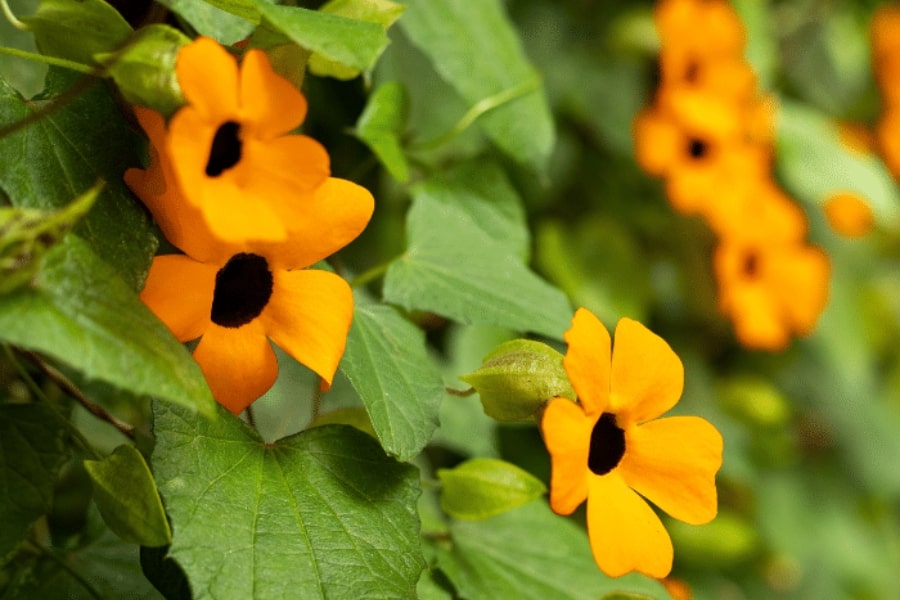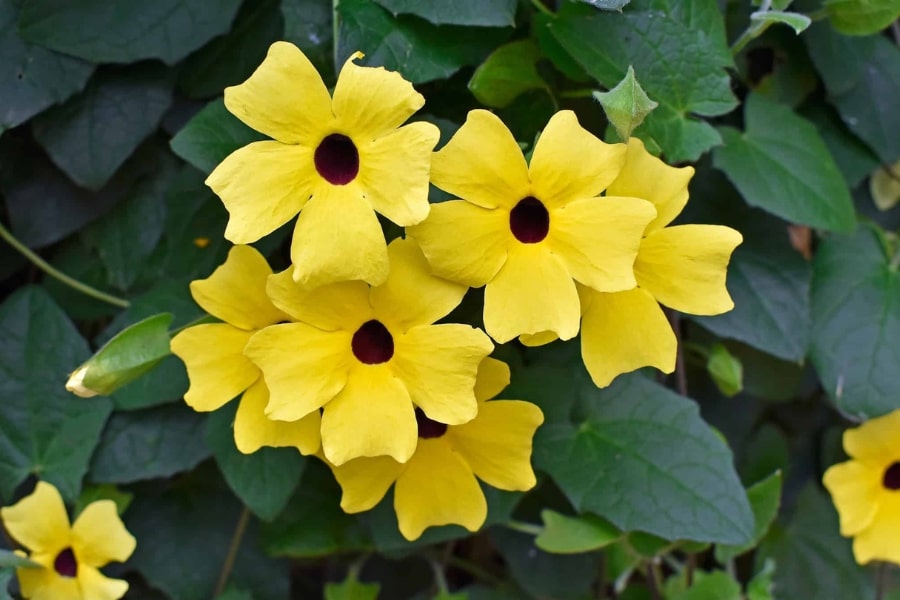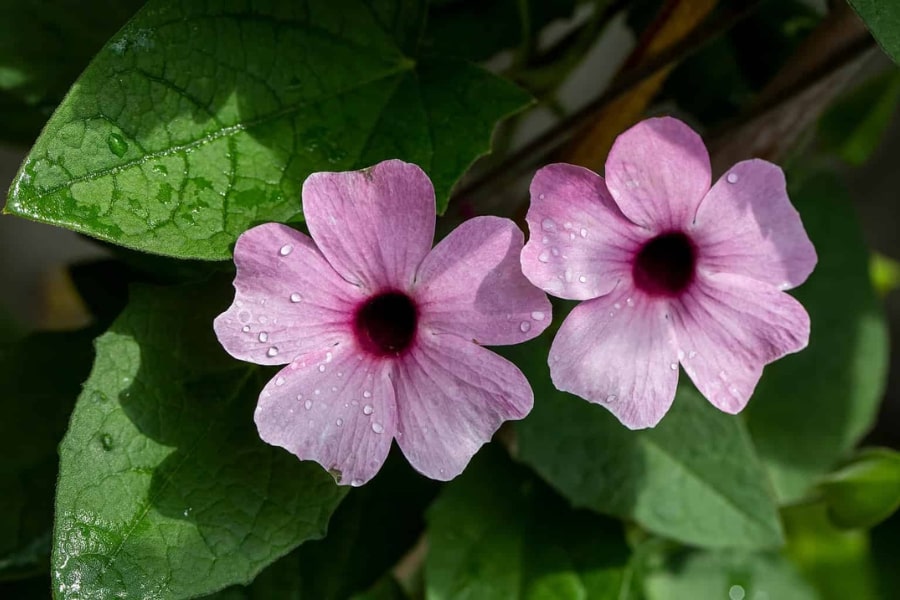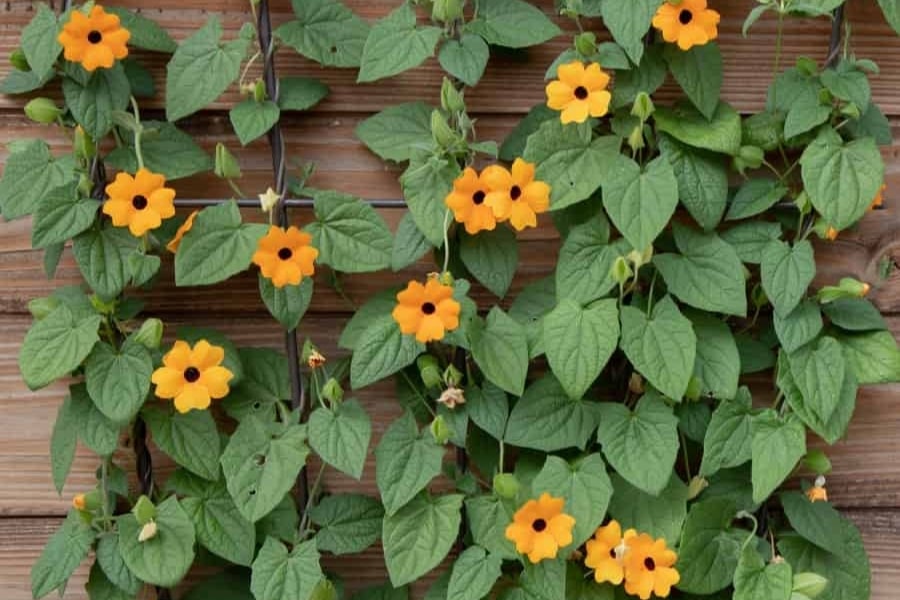Thunbergia, also known as Black-eyed Susan Vine, is a fast-growing flowering plant in the Acanthaceae family. It is native to tropical regions of Africa, Asia, and Madagascar. The plant was named after the Swedish botanist Carl Peter Thunberg, who discovered the species in South Africa in the 18th century. Thunbergia is known for its beautiful flowers and ability to quickly cover trellises, fences, and walls. If it has a support structure to climb, Thunbergia can climb upwards of 8 feet high.

Our Selection of Thunbergia
At Martin Garden Center, we grow a variety of colors of Thunbergia alata in a 4″ vine and we also offer hanging baskets. In 2025, we are growing 5 varieties:
- Sunny Susy New Orange
- Sunny Susy Pink Beauty
- Sunny Susy White Halo
- Sunny Susy Yellow Dark Eye
- TowerPower Apricot
Due to the quick growth of this vine, these baskets and 4″ plants are usually gone by the end of April. Currently, we do not have other vendor sources of this vine but we are always hopeful.
Growing and Caring For Thunbergia
Thunbergia thrives in warm and tropical climates, making it an excellent choice for gardens in those regions. It prefers full sun exposure to ensure optimal growth and abundant flowering. However, in hotter regions, it can benefit from some partial shade during the hottest parts of the day. The vine requires well-draining soil that is rich in organic matter. Regular watering is essential, especially during dry periods, to keep the soil consistently moist but not soggy. Adding a layer of mulch around the base of the plant helps retain moisture and suppress weed growth.
Black Eyed Susan is often grown as an annual in cooler climates, but it is a perennial in its native tropical regions. It can tolerate drought but thrives with regular watering and fertilization. It’s important to provide sturdy support for the vine to climb, such as a trellis or wire frame. Regular pruning and training can help maintain its shape and encourage lateral branching, resulting in a fuller and more compact growth habit. Thunbergia is relatively disease and pest resistant. Thrip is the only pest that we’ve found present and it can be treated organically with Spinosad. Other pests can be treated with the information in our pest guide.

Leaves and Flowers
The Black-eyed Susan Vine has attractive, heart-shaped leaves that are dark green and glossy. The plant produces small, trumpet-shaped flowers that in colors including pink, white, yellow, orange and red, with a black center, resembling the eyes of a black-eyed Susan.
The flowers of the Black-eyed Susan vine are a sight to behold with their striking beauty. These vibrant blooms feature a prominent dark center, surrounded by cheerful petals in shades of yellow, orange, or white. The petals often display delicate markings or contrasting patterns, adding an extra layer of charm to the flowers. These dainty blossoms, arranged in clusters along the vine’s twining stems, create a captivating display that brightens any garden or trellis.

Uses in Gardening and Landscaping
Thunbergia’s twining vines adorned with vibrant, trumpet-shaped flowers make it an excellent choice for trellises, fences, and pergolas. Its rapid growth and ability to cover vertical spaces quickly contribute to creating visually appealing vertical gardens, adding a vertical dimension to landscapes. Thunbergia’s flowers, which often feature a distinctive dark center, attract pollinators like bees and butterflies, enhancing the garden’s biodiversity.
Another notable use of Thunbergia is in hanging baskets and container gardening. Certain Thunbergia varieties’ have a trailing and cascading growth habit, which makes them well-suited for hanging baskets, where their lush foliage and colorful blooms can gracefully spill over the edges. Thunbergia adds a burst of color and texture in containers, making it an attractive choice for patio or balcony gardens.

Frequently Asked Questions
Do Hummingbirds Like Thunbergia?
Yes, Hummingbirds are attracted to the brightly colored, tubular flowers of Thunbergia. Incorporating Black-eyed Susan Vine in your garden can attract hummingbirds, providing them with a nectar-rich food source.
Does Thunbergia Come Back Every Year?
Black-eyed Susan Vine is typically grown as an annual in most regions, including the Upstate. Thunbergia may exhibit perennial characteristics, coming back year after year in areas with mild winters or tropical climates. To determine its specific behavior in your region, consider local climate conditions and whether Thunbergia can withstand winter temperatures.
Do Deer Eat Thunbergia?
Thunbergia is typically not a preferred food source for deer. While no plant can be considered completely deer-proof, Thunbergia is often considered deer-resistant due to its tough foliage and possibly its taste or texture. While deer may browse on Thunbergia if other food sources are scarce or are particularly hungry, they are less likely to target it than more palatable plants.
